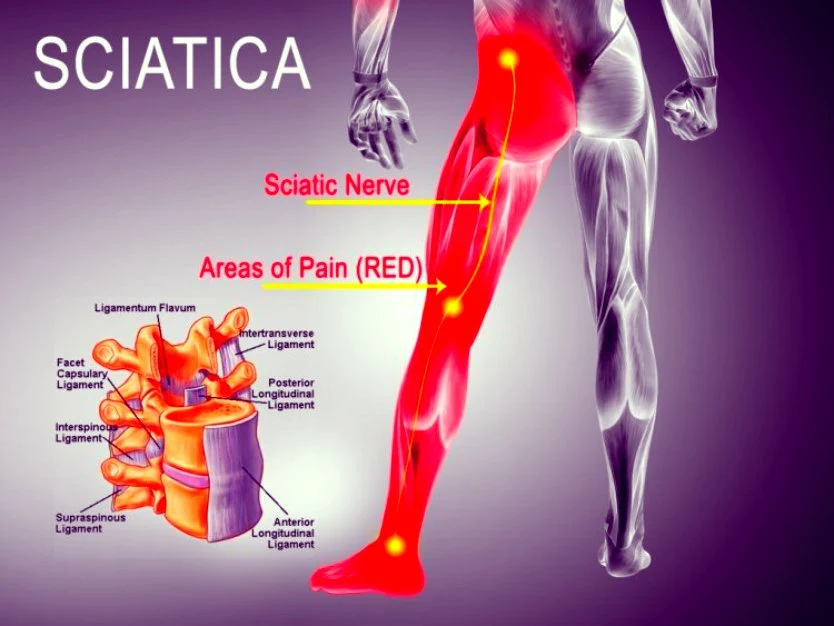What Is Sciatic Nerve Pain?
Sciatica occurs when certain nerves are pinched in the lower spine, affecting the sciatic nerve. This results in intense pain that extends down the legs. Sciatica symptoms include:
- Severe pain while sitting
- Pain that makes standing or walking difficult
- Typically, only one leg is affected
- A tingling, burning, or searing sensation in the leg
- Pain that extends to the foot and toes
- Weakness and difficulty moving the leg, foot, or toes
Common causes of sciatic nerve pain include a slipped or herniated disc, spinal injury, spinal stenosis, isthmic spondylolisthesis, or piriformis syndrome, and it may also arise during pregnancy due to organ rearrangement and spinal pressure.
8 Remedies for Sciatic Nerve Pain
With numerous alternative treatments available, surgery and over-the-counter medications should be considered last. Here are 8 natural remedies to relieve sciatic nerve pain:
1. Acupuncture
Warming acupuncture, which involves heating the needles, has been found to offer relief for individuals suffering from sciatica. A particular study revealed that out of 30 participants, 57% were cured, 33% showed improvement, and 10% saw no change, resulting in a total efficacy rate of 90%.
2. Chiropractic Adjustments
As previously stated, 60% of sciatica sufferers who did not find relief from other treatments and then underwent spinal manipulation reported the same degree of pain relief as those who underwent surgery. Chiropractic care elicits a response in the nervous system that alleviates pain and realigns nerves and joints to their correct position.
3. Hot and Cold Compresses
Alternating between a hot and cold compress can soothe nerves and muscles, while simultaneously reducing pain and swelling. It's advisable to begin with heat and conclude with cold. Apply each compress for 15-20 minutes before switching. Relief should typically be felt within an hour.
4. Yoga
Gentle yoga has been a tremendous help for my sciatica. It strengthens muscles and enhances flexibility, preventing the recurrence of postures that aggravate sciatic nerve pain. A study has shown that yoga therapy is safe and beneficial for individuals with non-specific lower back pain or sciatica, especially those with disc extrusions and bulges.
5. Deep Tissue Massage
I also found deep tissue massage effective in alleviating sciatic nerve pain. Trigger-point therapy is particularly beneficial. The sciatic nerve lies beneath the piriformis muscle, which is just below the glutes. When the piriformis muscle is tight, it can compress the sciatic nerve, causing numbness and tingling down the leg. Scheduling massages 10 days apart and continuing for four sessions often helps. If not, consider exploring other pain relief methods.
6. Turmeric
Inflammation is a primary cause of sciatic nerve pain, which is why you feel the pain initially. Turmeric serves as an excellent remedy for sciatica, and consuming it also offers numerous other health advantages. Combine 1 cup of coconut milk with 1 tsp. of turmeric and a pinch of black pepper. Warm it up and enjoy. The coconut milk and black pepper enhance the absorption of turmeric's beneficial compounds.
7. Fenugreek Seeds
Fenugreek serves as an anti-inflammatory agent that can alleviate sciatic nerve pain. To use, grind a handful of fenugreek seeds and boil the resulting powder in water to form a mushy paste. Apply this paste to the affected area, leave it on for a few hours, then rinse off. Continue this process until you achieve the desired results. You can also incorporate fenugreek into your diet to enjoy its benefits.
8. Physical Activity
It's crucial to stay active when dealing with sciatic nerve pain. Remaining in bed all day can exacerbate the discomfort. Engaging in daily activities can fortify your core muscles and enhance your posture, particularly by avoiding prolonged sitting. Incorporating specific exercises and stretches for your condition can also help alleviate tension in the inflamed areas.








Comments